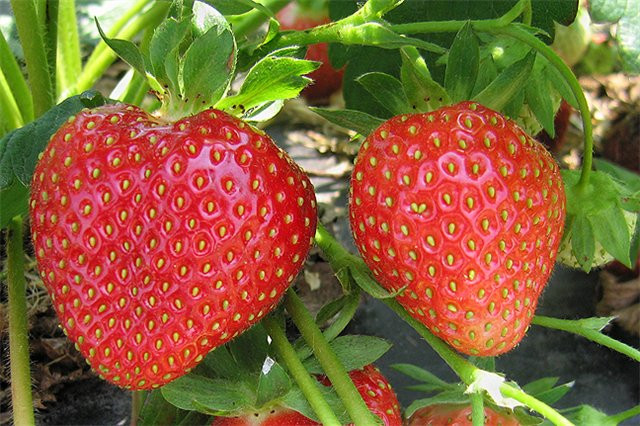Many novice gardeners believe that they are engaged in the cultivation of strawberries, but more often at the dacha plots you can find garden strawberries, which ordinary people call strawberries.
One of the most outstanding varieties is Kimberly, it has excellent taste and good yield. In this article we will get acquainted with the description of the Kimberley strawberry variety, we will learn how to care for and fight pests.
Table of contents
Description varieties of strawberries Kimberley
The Wim Kimberly variety belongs to the results of the work of Dutch breeders and is a fairly small but powerful shrub. The leaves are small, rounded, on closer examination, you can see an oily sheen. Inflorescences are usually located either at the level of the leaves, or slightly lower. The mustache grows rather slowly.
A distinctive feature of the variety is high yield. (1.5 - 2 kilograms from one bush), while the peak is observed at 2-3 years of life. Fruiting plants occurs in early July and lasts about 2-3 weeks.
Kimberley garden strawberries are quite frost-resistant and suitable for growing in temperate climates, and the shrub feels good in the southern regions.
Characteristics of the fruit
Berries collected from the bush strawberry varieties Kimberley have excellent taste and aroma, experts rate this figure on the highest scale. On average, one berry weighs 40-50 grams. The shape of the fruit resembles a cone, the color is rich red, the presence of luster on the surface is noted.
In addition to all the other positive qualities, Kimberly berries are well transported and universal in use.
Breeding history
Garden strawberries of the Kimberley variety were born in Holland by crossing the Gorella and Chandler varieties. Kimberly is actively grown in Europe and central Russia, It tolerates cold and frost well, the main thing is to ensure proper care and protection.
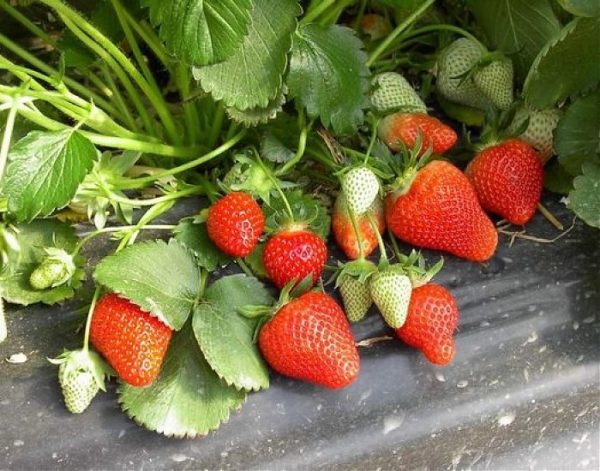
Advantages and disadvantages
- Ripe fruits can be harvested at very early stages;
- Due to the nature of the bush, the fruit does not lean toward the ground;
- The berries are very dense, without internal voids;
- Also, the fruits are very tasty and high quality;
- Good transportability and presentation make Kimberley one of the best varieties for commercial use;
- The variety is not afraid of the cold;
- It is resistant to many fungal diseases.
- This variety has poor drought tolerance;
- The period of fruiting lasts a relatively short time (14-21 days);
- Strawberry bushes are often attacked by pests.
Landing rules
To garden strawberries brought a good harvest, you must properly plant the plant. The ideal landing site meets the following criteria:
- the plot must be smooth;
- preferably located in the south or south-west;
- it is forbidden to plant strawberries on the southern slopes, because snow melts on them very quickly and the soil dries out.
After the choice of a site is left behind, it is necessary to prepare it correctly:
- initially, the future ridge is carefully weeded to get rid of weeds;
- then on 1 square meter of soil for digging make 7-10 kilograms of humus;
- the work itself can be done in 10-14 days.
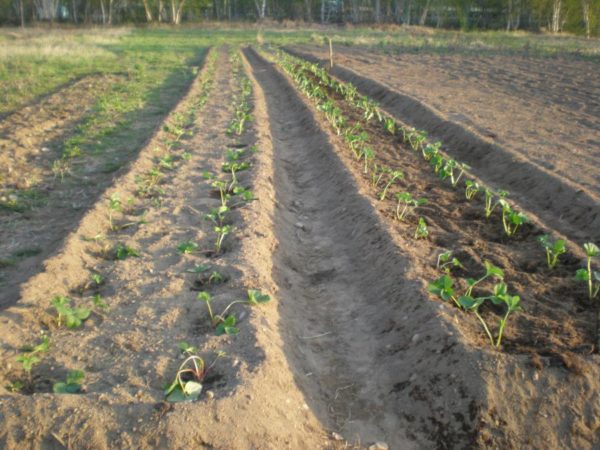
Planting strawberries is best done at the end of March or in September. The work is carried out in accordance with the following recommendations:
- First, you need to make small grooves at a distance of 60-80 centimeters from each other;
- Then the wells moisten abundantly;
- To ensure that moisture evaporates as slowly as possible on the stem, leave only one leaf;
- At the bottom of the hole, a small mound is made and a plant is placed there, while gently straightening the root system;
- Then the hole is covered with earth so that the central kidney, which looks like a heart, remains on the surface.
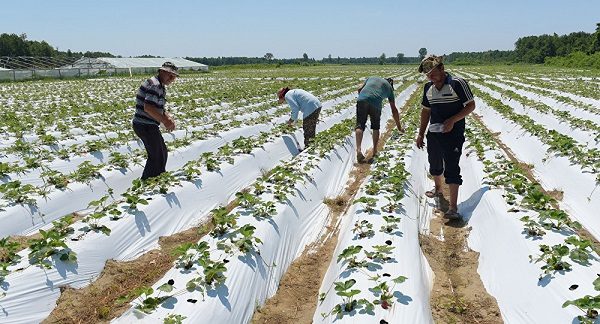
Care
There are several rules on the observance of which the quantity of the future harvest directly depends.
The Kimberley variety needs a lot of moisture, so during the week after planting the plant is watered every day. In the subsequent period, the soil is moistened once in 7-10 days, during the ripening of the fruits, strawberries are watered every 3-5 days.
It is also very important to monitor weather conditions and when drought occurs, the frequency of watering should be increased. Immediately after wetting the land is recommended to carefully loosen and remove weeds.
Experienced gardeners came to the conclusion that the best protection against the rapid evaporation of moisture, disease, pests and weeds is considered to be mulching. Also, this procedure will help protect the berries from contamination.Strawberry beds are usually covered with the following materials:
- sawdust;
- straw;
- spruce needles;
- agrofibre;
- cardboard.
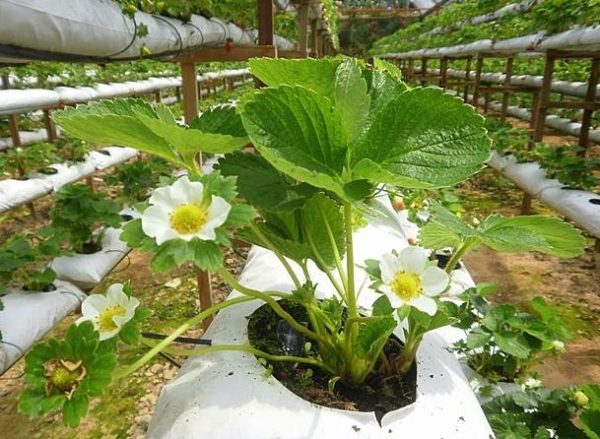
Top dressing
One of the most important components of garden strawberry care is the timely application of fertilizers.
| In early spring, before the formation of new leaves. | Under each bush poured 500 ml of solution, which is prepared in the following proportions:
· 1 tablespoon of sodium humane; · 1 tablespoon of urea; · 10 liters of water. |
| When the first leaves. | The plant is watered with a solution prepared from 1 tablespoon of nitroammofoski and 10 liters of water;
Also, each bush is sprayed with urea, half a tablespoon of which is diluted in 2 liters of water. |
| With the formation of the first fruits. | A tablespoon of potassium sulfur is diluted with 5 liters of water and applied under the plant root;
One tablespoon of ash is poured with half a liter of water and infused for 24 hours, then this mixture is periodically used instead of water during watering. |
| September 10-20. | Under digging make one bucket with a rotted mullein and 100 grams of water;
After 10-14 days, a solution is prepared from one tablespoon of nitrophoska, 100 grams of ash, 15 grams of potassium sulfate and half a bucket of water, then the bushes of garden strawberries are watered. |
Features grade
- Kimberly garden strawberries can be grown in almost all regions of Russia, This is possible due to the increased frost resistance of the variety. But it should be noted that in the north of the country shrubs require additional shelter for the winter period, it is also necessary to protect the plant during the spring frosts;
- The most important feature of these berries will be great taste, which is often called caramel;
- Also, due to the good density of the berries and the absence of internal voids, such a variety tolerates transportation;
- Usually, ripening occurs in early June, but if you use the technique of growing strawberries in the tunnels, you can get a harvest in mid-May.
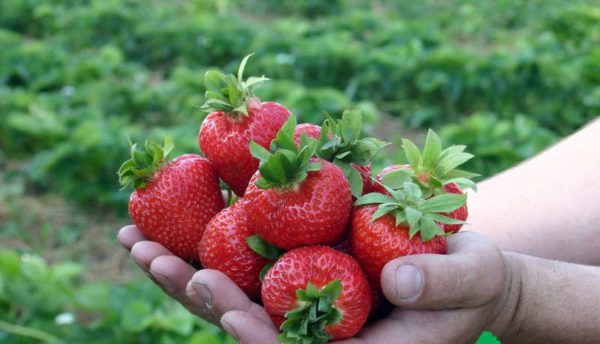
Diseases and pests
Kimberly strawberry variety has good immunity to powdery mildew and other fungal diseases, most often on such plants can be found:
- gray rot;
- nematode.
Pests also attack garden strawberries much more often, the following insects are commonly found:
- larvae of the May beetle;
- wireworm;
- strawberry clear mite;
- weevil;
- aphid.
General prevention will be:
- Autumn soil digging;
- Removal of affected plant parts;
- Timely removal of weeds;
- After harvest, the bushes are sprayed with a 3% solution of Karbofos;
- Applying the required amount of fertilizer;
- In early spring, strawberries are treated with 15 milliliters of ammonia, diluted in 10 liters of water.
When various pests appear, the following control methods are used:
- Manual insect removal;
- When pests appear on the seedlings, it is necessary to immerse the roots in water heated to 45 degrees and hold in it for 10-15 minutes, then rinse them under running water;
- You can also spray bushes infusion, prepared according to the following recipe: 500 grams of dandelions are placed in a bucket of warm water and infused for about 3 hours;
- Another effective tool will be a few heads of garlic, filled with 3 liters of water. They need to insist 7-10 days and spray them garden strawberries.
Garden strawberries Kimberley is considered one of the best varieties. Fruits differ in the big size, beautiful appearance and excellent taste. Plant care is quite simple, the main condition is timely watering.
